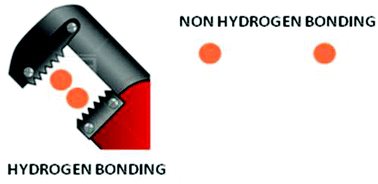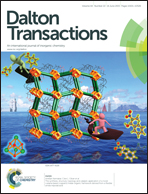Intramolecular hydrogen bonding stabilizes the nuclearity of complexes. A comparative study based on the H-carborane and Me-carborane framework†‡
Abstract
New dinuclear carboranylcarboxylate-bridged and mononuclear copper(II) compounds containing the 1-CO2H-2-H-1,2-closo-C2B10H10 carborane ligand (LH) have been synthesized from the previously synthesized dinuclear compound [Cu2(μ-L)4(THF)2], 1. Reaction of LH with CuSO4 in THF leads to the dinuclear compound [Cu2(μ-L)4(THF)2], 1. The reaction of 1 with different terminal pyridyl ligands leads to the formation of a series of structurally analogous complexes by substitution of the terminal ligand THF (Lt = py, 2; p-CF3-py, 3; p-CH3-py, 4), which maintain the structural Cu2(μ-O2CR)4 core in most of the cases except for o-(CH3)2-py where a mononuclear compound (5) is exclusively obtained. In the case of 2 and 4, other dinuclear compounds [Cu2(L)4(Lt)4], 2′ and 4′ are obtained in lower yield. These compounds have been characterized using analytical, spectroscopic (NMR, IR, UV-visible) and electrochemical techniques (CV, DPV). X-ray analysis revealed a paddle-wheel structure for the main dinuclear compounds with a square-pyramidal geometry around each copper ion and the carboranylcarboxylate ions bridging two copper atoms in syn–syn mode. In the case of 2′ and 4′ there are two carboranylcarboxylate ions bridging the copper atoms in syn–anti mode whereas the other two adopt a monodentate coordination mode. The mononuclear complex obtained with the o-(CH3)-py ligand presents a square-planar structure, in which the carboranylcarboxylate ligand adoptsmonodentate coordination. The effect of the substituent group on the cluster of the carboranylcarboxylate ligands on the reactivity of compound 1 is also discussed.

- This article is part of the themed collection: In memory of Professor Kenneth Wade

 Please wait while we load your content...
Please wait while we load your content...